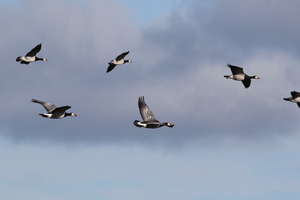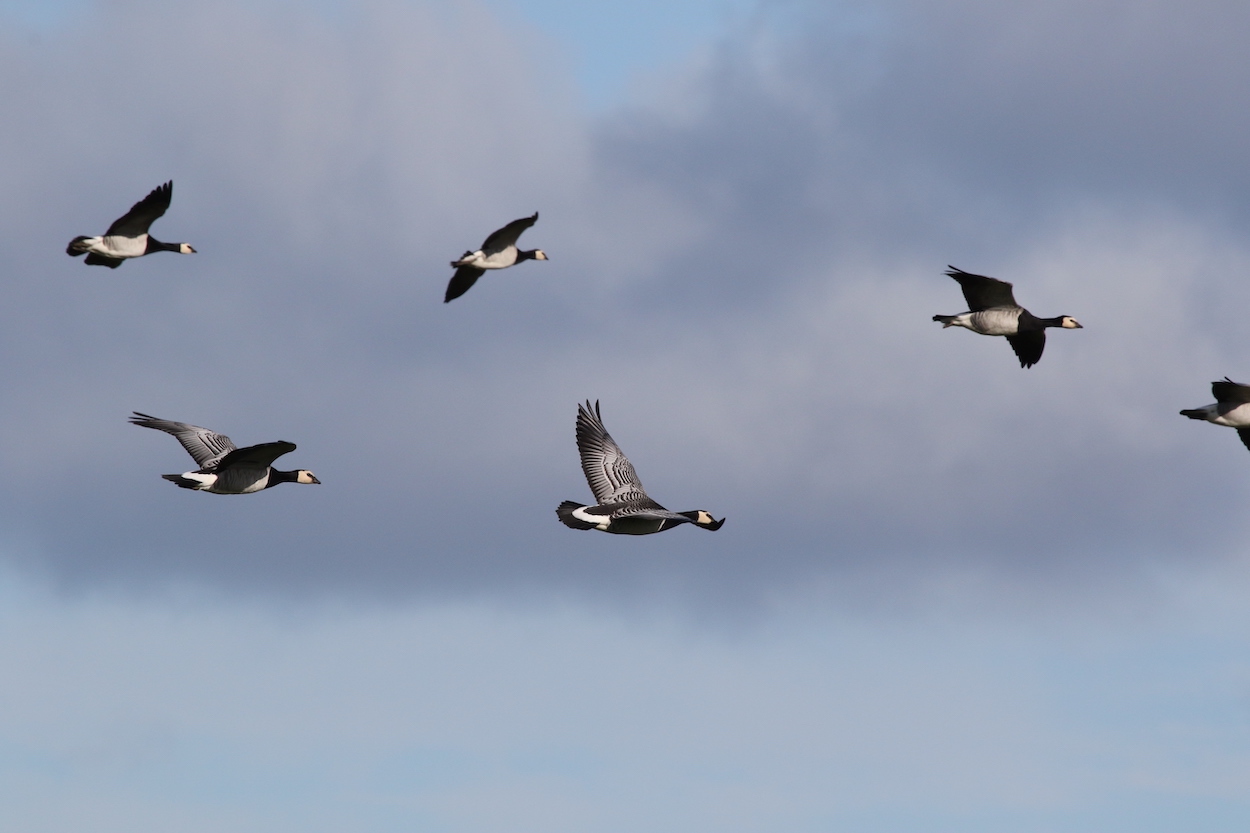 LINKED PAPER
LINKED PAPER
Incidence of lead ingestion in managed goose populations and the efficacy of imposed restrictions on the use of lead shot. McIntosh, A.L.S., Ozsanlav-Harris, L., Taggart, M.A., Shaw, J.M., Hilton, G.M. & Bearhop, S. 2023 Ibis. doi: 10.1111/ibi.13210 VIEW
Despite its known toxic effect, the deposition of anthropogenic lead due to shooting activities continues to pose a threat to numerous species worldwide, with lead able to affect most physiological systems causing morbidity and mortality. For many bird taxa, direct ingestion when foraging for food or grit is the primary source of lead poisoning (Fig. 1). In the UK an estimated 50 000 – 100 000 wildfowl die annually due to ingestion of spent lead gunshot, with greater numbers suffering from further fitness effects such as reductions in productivity and migratory performance (Pain et al. 2019). As lead pellets are slow to degrade they can accumulate, particularly in areas of intense, regular shooting. Consequently, the risk of lead poisoning can persist long after shooting with lead has ceased (Pain et al. 2019).

Figure 1 X-rays of live-caught Barnacle Geese on Islay. (a) depicts a clean x-ray with no ingested or embedded shot, (b) depicts ingested shot in the gizzard (in red).
Numerous restrictions and legislation have been implemented to reduce the impact of lead on future populations. These include habitat- and species-specific bans on the use and trade of lead. Restrictions such as the recent EU ban (http://data.europa.eu/eli/reg/2021/57/oj) on the use of lead gunshot in and around wetlands are vital to prevent the further contamination of these key sites. However, restrictions such as these typically do not cover all habitats used by waterfowl and necessitate high compliance and effective enforcement (Green et al. 2022). Additionally, historically deposited lead remains a problem long after bans have been introduced (Newth et al. 2012).
On Islay, Scotland, Greenland Barnacle Geese (Branta leucopsis) have been shot as part of a long-term management scheme operated by NatureScot. The use of lead shot was banned on Scottish Ramsar wetlands in 2004 (and NatureScot ceased using lead ammunition on Islay in November 2020), but Barnacle Geese preferentially forage on agricultural grassland which has been targeted for shooting management and is typically outside of Ramsar sites. Consequently, Barnacle Geese foraging on Islay are still at risk of ingesting lead pellets when foraging (Fig. 2). Additionally, the Greenland White-fronted Goose (Anser albifrons flavirostris), which has undergone significant population declines, forage in many of the same areas as Barnacle Geese and is therefore also at risk of ingesting anthropogenic lead.

Figure 2 Minimum number of lead shotgun cartridges fired on each field on Islay from 2005-2019 as part of the goose management scheme. Collection sites of faecal samples are depicted (circles for non-outliers and green triangles for outliers), grey areas depict non-agricultural habitats.
In our recent paper in Ibis, we use a combination of faecal sampling (Martínez-Haro et al. 2010), x-ray screening of live-caught birds and post-mortem assessments of Barnacle Geese to determine the ingestion rate of lead shot in these two goose populations wintering on Islay. As shooting management has been coordinated by NatureScot we were able to assess the effectiveness of site-specific restrictions on the use of lead in reducing additional mortality due to lead poisoning from the goose management scheme.

Figure 3 The relationship between the amount of lead and aluminium in faecal samples of Barnacle Geese (GBG) and White-fronted Goose (GWfG) collected on Islay. Aluminium concentrations in the faeces are used as an assessment of the amount of soil ingestion which is typically closely correlated with lead when there is no additional lead ingestion such as from lead shot. Outliers above the shaded confidence and prediction interval (grey) indicate elevated faecal lead which may be indicative of shot ingestion.
Despite extensive annual deposition (until 2020) and potential accumulation of lead gunshot as part of the goose management scheme on Islay, across all evidence streams we found that neither species appears to be experiencing high rates of instantaneous lead ingestion. Furthermore, only four White-fronted Goose samples had elevated faecal lead concentrations and variation in faecal lead concentrations did not appear to be explained by the intensity of shooting as part of the goose scheme (Fig. 3). These results are likely due to the spatially restrictive ban on the use of lead shot minimising likely lead ingestion for three main reasons. First, high risk sites where grit is usually ingested such as roosts (as indicated from post-mortem analysis) are protected within Ramsar sites thus minimising lead deposition in these areas. Second, shooting with lead shot is limited to specific fields within improved grassland areas, thus providing large areas of foraging habitat with little deposited anthropogenic lead. Third, foraging on grassland is associated with lower shot ingestion rates than other habitats owing to the pecking behaviour on uniform grass swards (Green and Pain 2016).
Our results demonstrate that a spatially restrictive ban on the use of lead shot with high compliance and enforcement can effectively reduce lead shot ingestion in target populations (though not eliminate it entirely). Partial bans on the use of lead shot can be effective in preventing further deposition of lead shot and reducing future lead poisoning, however, they often fail to protect all foraging sites leaving some species at risk when utilising areas outside of controlled areas. Greater spatial restrictions on the use of lead shot, combined with further monitoring of shooting and hunting practices to ensure high compliance with legislation are likely to aid the safeguarding of wildfowl from lead in the future.
References
Green, R.E., Taggart, M.A., Pain, D.J., Clark, N.A., Clewley, L., Cromie, R., Dodd, S.G., Elliot, B., Green, R.M.W., Huntley, B., Huntley, J., Pap, S., Porter, R., Robinson, J., Sheldon, R., Smith, K.W., Smith, L., Spencer, J. & Stroud, D. 2022. Effectiveness of actions intended to achieve a voluntary transition from the use of lead to non-lead shotgun ammunition for hunting in Britain. Conservation Evidence 19:8-14. VIEW
Martínez-Haro, M., Taggart, M.A. & Mateo, R. 2010. Pb-Al relationships in waterfowl feces discriminate between sources of Pb exposure. Environmental Pollution 158:2485-2489. VIEW
Newth, J.L., Cromie, R.L., Brown, M.J., Delahay, R.J., Meharg, A.A., Deacon, C., Norton, G.J., O’Brien, M.F. & Pain, D.J. 2012. Poisoning from lead gunshot: still a threat to wild waterbirds in Britain. European Journal of Wildlife Research 59:195-204. VIEW
Green, R.E. & Pain, D.J. 2016. Possible effects of ingested lead gunshot on populations of ducks wintering in the UK. Ibis 158:699-710. VIEW
Pain, D.J, Mateo, R & Green, R.E. 2019. Effects of lead from ammunition on birds and other wildlife: a review and update. Ambio 48:935-953. VIEW
Image credit
Top right: Greenland Barnacle Goose (Branta leucopsis) and Greenland White-fronted goose (Anser albifrons flavirostris) © Aimée L.S. McIntosh.
If you want to write about your research in #theBOUblog, then please see here.




